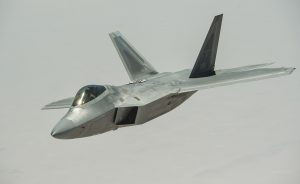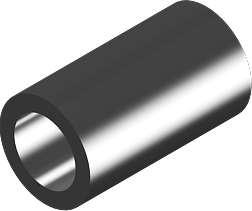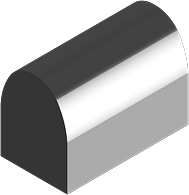Stainless Steel 17-7PH
View AMS Numbers >
Stainless Steel 17-7PH
17-7PH Stainless Steel is a semi-austenitic precipitation hardening steel with high levels of Chromium and Nickel. It is characterized by high strength and hardness, excellent fatigue properties, minimal distortion upon heat treatment, good formability in the annealed condition, and good corrosion resistance.
Thanks to its exceptional mechanical properties, this steel is often used in aerospace applications. It is also used for manufacturing of flat springs, conical springs, washers, eyelets, and strain gauges. 17-7PH Stainless Steel can be used in industrial atmospheres and fresh water due to its good corrosion resistance, but it is not the best choice for use in salt water or reducing environments.
Stainless Steel 17-7PH is available in three conditions – RH 950 and TH 1050, which can be hardened to high strength levels with simple heat treatments, and CH 900 which should be used in high-strength parts where excellent ductility and workability is not required.
Tech Steel & Materials offers Stainless Steel 17-7PH in four sub-type specifications and multiple shapes/forms:
- AMS 5528 (Plate, Sheet, and Strip)
- AMS 5529 (Sheet and Strip)
- AMS 5568 (Tubing)
- AMS 5644 (Bar and Forging)
Chemical Composition of Stainless Steel 17-7PH
| Element | min | max |
| Carbon, C | — | 0.09 |
| Manganese, Mn | — | 1 |
| Silicon, Si | — | 1 |
| Sulfur, S | — | 0.030 |
| Phosphorus, P | — | 0.040 |
| Chromium, Cr | 16 | 18 |
| Aluminum, Al | 0.75 | 1.50 |
| Nickel, Ni | 6.50 | 7.75 |
| Iron, Fe | — | *Balance |
*Not exclusively to the element mentioned, but that one predominates other elements that are used only in minimal quantities.
Fabrication and Working Instructions
Stainless Steel 17-7PH hardens rapidly during heat treatment and requires intermediate annealing in deep drawing or in forming intricate parts. In some conditions, like Condition C, for example, this steel can be very hard and strong, which means that advanced fabrication techniques for such materials should be used.
As for machining, special care must be applied to the speed at which the parts are machined. 17-7PH Stainless Steel can display long gummy chips during machining, and therefore slower speeds are recommended, accompanied by constant feeds.
17-7PH Stainless Steel can be welded by all conventional fusion and resistance techniques. However, if optimum mechanical properties are wanted, special care is recommended to find the best heat-treated conditions that should be done during the welding. The following heat treatments of the welded part are also essential for excellent mechanical properties. More precisely, austenite conditioning and precipitation hardening are mandatory after the welding is finished to obtain high strength.
Overall, 17-7PH is not as weldable as 17-4PH Stainless Steel. The reason for this is the high concentration of Aluminum, which deteriorates penetration of the weld, thus creating a bond that is not as strong. Weld slug formation can also be worsened during arc welding, which is another area that requires special care.
Mechanical Properties
| Property | Value |
| Tensile Strength | 170000 psi |
| Yield Strength | 140000 psi |
| Modulus of Elasticity | 29600 ksi |
| Poisson’s Ration | 0.27 – 0.30 |
| Elongation at Break | 6% |
| Hardness, Rockwell C | 38 |
Thermal Properties
| Property | Value |
| Thermal Conductivity | 114 BTU in/hr.ft2.°F |
| Thermal Expansion co-efficient | 6.11 µm/m°C |
Heat Treatment
Stainless Steel 17-7PH can be heat treated and annealed in electric furnaces, radiant tube furnaces that work both on oil and gas, and vacuum furnaces. The use of furnaces that use oil or natural gas fire is not recommended. Given the fact that 17-7PH doesn’t work well in reducing environments, heat treatment, and annealing in such atmospheres should be avoided. These atmospheres may be responsible for nitriding of the surface. If bright annealing is required, dry hydrogen, argon or helium atmosphere can be used at cooling rate of -65° F (-54° C).
Depending on the condition, different heat treatments of 17-7PH are recommended:
- Condition A – mill Annealed at 1950 ± 25° F (1066 ± 14° C).
- Condition A1750 – mill Annealed at 1950 ± 25° F (1066 ± 14° C), then heat to 1750 ± 15° F (954 ± 8° C) for 10 minutes and air cool to room temperature.
- Condition T – mill Annealed at 1950 ± 25° F (1066 ± 14° C), then heat to 1400 ± 25° F (760 ± 14° C) and hold for 90 minutes. Finally, cool to 60° F (16° C) within 1 hour and hold for 30 minutes.
- Condition TH 1050 – mill Annealed at 1950 ± 25° F (1066 ± 14° C), then heat to 1400 ± 25° F (760 ± 14° C) and hold for 90 minutes. Next, cool to 60° F (16° C) within 1 hour and hold for 30 minutes. Finally, heat to 1050 ± 10° F (566 ± 5.5° C) and hold for 90 minutes, then air cool to room temperature.
- Condition R 100 – mill Annealed at 1950 ± 25° F (1066 ± 14° C), then heat to 1750 ± 15° F (954 ± 8° C) for 10 minutes and air cool to room temperature. Within 1 hour, start cooling to -100 ± 10° F (73 ± 5.5° C) and hold for 8 hours before air warming to room temperature.
- Condition RH 950 – the same as Condition R 100 only with added precipitation hardening at 950 ± 10° F (510 ± 5.5° C) for 60 minutes and then air cooling to room temperature.
Select AMS Number:
| AMS Number | Alloy | Type | UNS | Cross Ref. Spec | Misc./Shape | |
|---|---|---|---|---|---|---|
| AMS 5528 Plate | 17-7PH | Stainless Steel | S17700 | MIL-S-25043 | Plate |
 |
| AMS 5528 Sheet | 17-7PH | Stainless Steel | S17700 | MIL-S-25043 | Sheet |
 |
| AMS 5528 Strip | 17-7PH | Stainless Steel | S17700 | MIL-S-25043 | Strip |
 |
| AMS 5529 Sheet | 17-7PH | Stainless Steel | S17700 | MIL-S-25043 | Sheet |
 |
| AMS 5529 Strip | 17-7PH | Stainless Steel | S17700 | MIL-S-25043 | Strip |
 |
| AMS 5568 |
17-7PH | Stainless Steel | S17700 | - | Tubing |
 |
| AMS 5644 Bar | 17-7PH | Stainless Steel | S17700 | - | Bar |
 |
| AMS 5644 Forging | 17-7PH | Stainless Steel | S17700 | - | Forging |
 |

 Tech Steel & Materials
Tech Steel & Materials